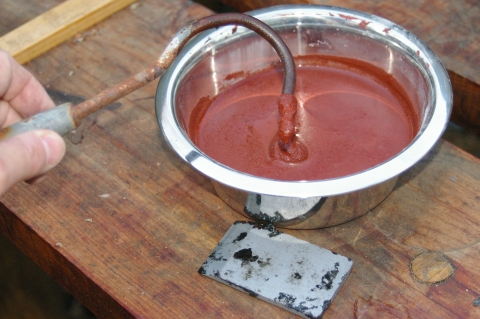Here is a bowl of goop. Below it is a blade I used the goop on. The blade was painted with the stuff, and then heated to a nice cherry red for about 15 minutes. Then it was quenched in safflower oil.

I had to put a cover on the oil, the oil caught on fire. No big issue, the oil was on some wax so the blade was suspended and able to continue cooling. The melting wax provides a bit of circulation, so for treating O1 it works out well enough.
I have not cleaned the blade off yet, but look how clean it is. No oxidation, no scale, no deformation. I will be treating my steel like this in the future.
The goop is a mix of boric acid, water and iron oxide. I mixed up about eleven parts of boric acid to one part of iron oxide. Stirred it around in water to make a paste. This stuff is great. Normally you have to remove the outer layer of steel as it has puffed up and become brittle hard scale.
Bob
 A page Dedicated to My Writing
A page Dedicated to My Writing
Hello Bob;
Interesting concept. Where did you see the formula to make the mix????
How many blades are you treating?
Are you treating anything else at the same time?
Care to mention the project you are treating the blades for?
Well done!
Skip
This is a pretty ancient blacksmith mix, usually 50% ultra fine ground iron oxide, 50% Borax. Some folk use Boric Acid instead, they usually prefer at least a little boric acid. Usually they get the iron warmly glowing and then plunge it into the borax mix to melt a coating onto the iron.
In fine metalwork with steel, often boric acid is dissolved in alcohol and painted on parts before soldering. This prevents oxidation of the steel, Oxidation prevents a good soldier coating or bond. Oxidation also eats away at the steel surface.
Normally you use borax that you baked the moisture out for flux. Since I have plenty of heat when I am metalworking, I painted it on wet and let it dry by slow heating. Then when the steel gets really hot, the flux melts evenly.
A formula for welding, that made it’s way around the SCA was the following,
5 parts Anhydrous Borax
2 parts powder Boric Acid
2 parts Flourspar (calcium flouiride)
1 1/2 parts powdered red iron oxide
1/2 part powdered Sal Amoniac
1/2 part non iodized Salt
This is formula is considered one of the best and most reliable.
In this case I am not welding, the point here is to make a glass layer that prevents oxidation, and even dissolves oxides. Boric acid dissolves the Iron oxide and makes a nice protective and even cleaning layer.
I will be making quite a few planes shortly one of them will use a lot of blades. So I need to perfect my methods so I don’t have to do a lot of cleanup and grinding after it is all done.
Bob
My only experience heat treating is for a pair of molding planes, and with those scale was a minimal problem and we intentionally heated the tangs to oxidize them to turn them black. Is your attempt to limit scale and oxidation just to have a clean look to it?
We also heated to a tangerine color, watched for tiny eruptions, then quenched. I assume the difference compared to your cherry red for 15 minutes was a different hardness, right?
Heating at lower temperatures than cherry red, for hardening O1, may reduce the amount of carbides produced in the hardening process. Heating to cherry red is the first step to hardening, you can heat to cherry and then quench to harden, but a soak period is better. However, the cherry red soak time is where the chance of loosing temper to the air comes in. By preventing scale, I also prevent a degradation of the metals properties.
You can wrap your tool in stainless steel foil, but that is expensive. You can run your kiln or forge to have low available oxygen, a lot of people do. I think having a glassy layer on the steel is a good reliable method.
By having a nice long soak period at a high temperature, I reduce the internal tensions of the metal, created by shaping and the heat from grinding. A lot of smiths quench the steel without a soak time and have good results. A decent soak period is however a good way to maintain consistent results. Another advantage to an extended heat soak, is the steel will remain hot a touch longer, giving you a bit more time to move the steel from forge to quench. Being in a hurry with glowing steel is bad luck.
While it is still cherry red, I cool it in oil to harden it. The ideal is to stir the steel around in the oil to make sure of an even quench. After it is cool, I wash it and clean it.
At this point the steel is way too hard and can shatter. It needs to be tempered to the correct hardness for the job. Several ways to temper, my method is to heat it up in an electric deep fryer. This way I can control temperature and put the temper on the steel that I desire. I want the steel hard enough to hold a good edge, but soft enough to be resilient and easy to sharpen. By heating it in oil, I maintain the nice finish and I make sure of an even steady tempering.
Here is a really good guide to heat treating, http://www.threeplanes.net/toolsteel.html
Bob